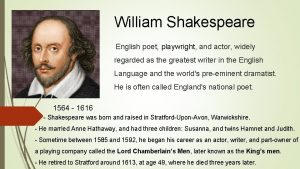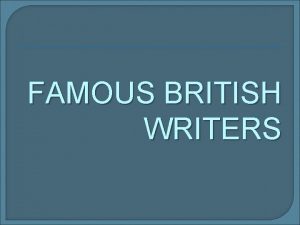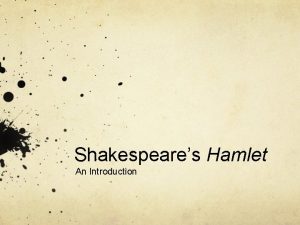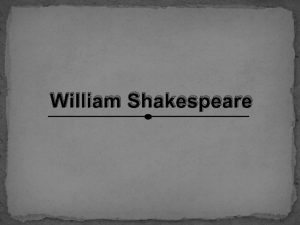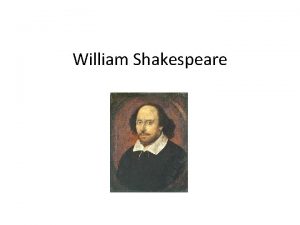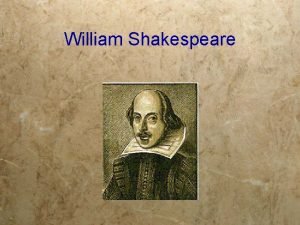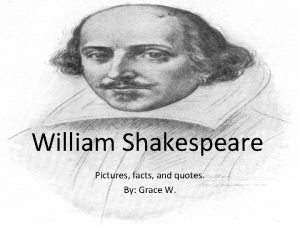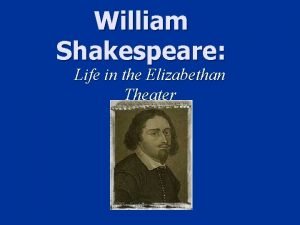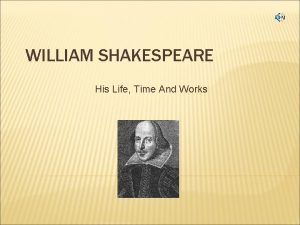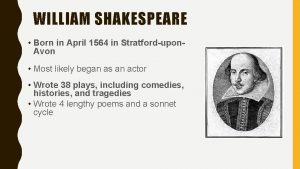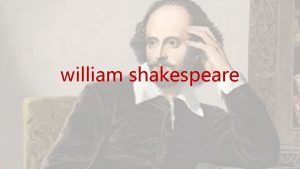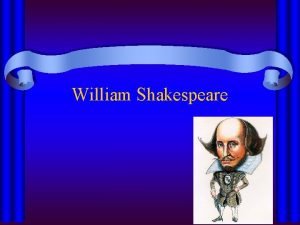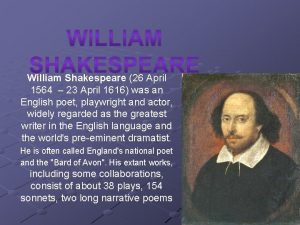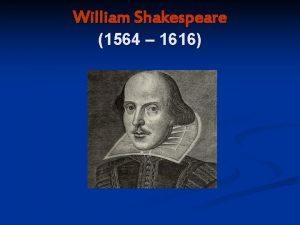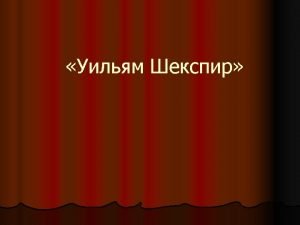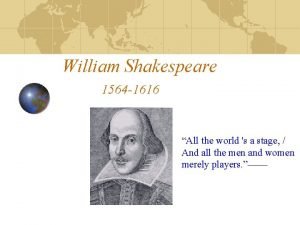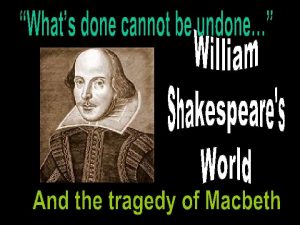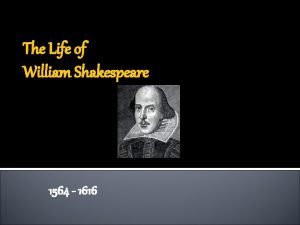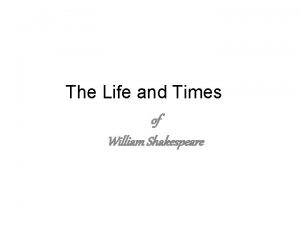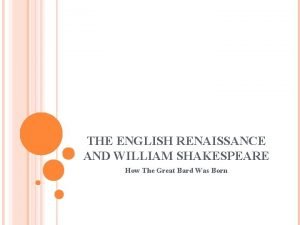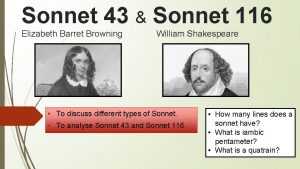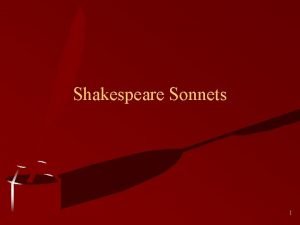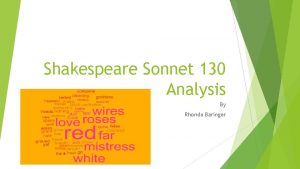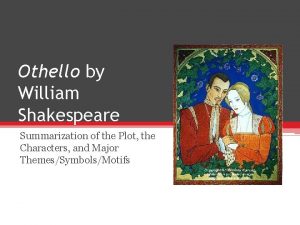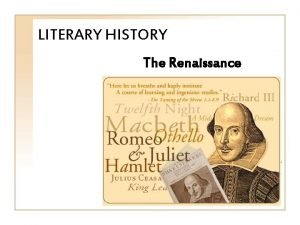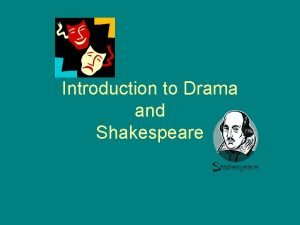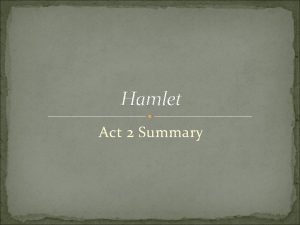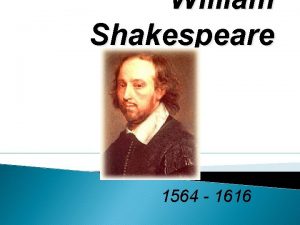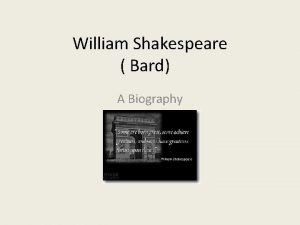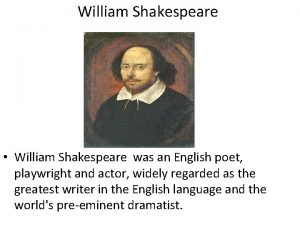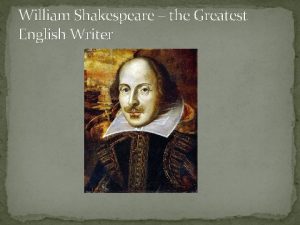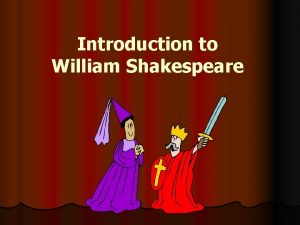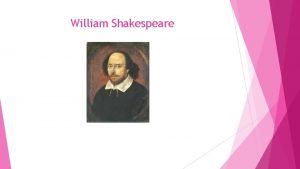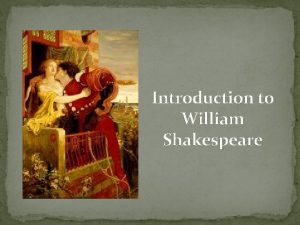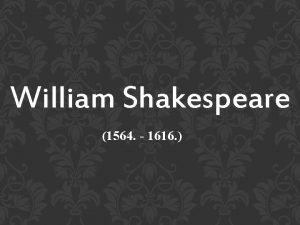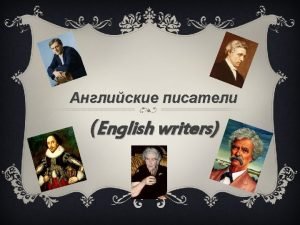Introduction to Shakespeare English 10 William Shakespeare Shakespeare










































- Slides: 42

Introduction to Shakespeare English 10

William Shakespeare


Shakespeare The man, the myth, the legend William Shakespeare was born the third of eight children on April 23, 1564, in the town of Stratford-upon-Avon, England, to Mary Arden and John Shakespeare. His father, John, was a shopkeeper and a man of some importance in Stratford who served at various times as justice of the peace and high bailiff (mayor).

Shakespeare’s Birthplace

…As it is today.

Education William attended grammar school where he studied Latin grammar, Latin literature, and rhetoric (the uses of language). As far as we know, he had no formal education.

King Edward VI Grammar School at Stratford-upon-Avon

Let There Be Love… At the age of eighteen, Shakespeare fell in love with Anne Hathaway who was 26. They married and had three children. Susanna was the oldest and Hamnet and Judith were twins. Hamnet died as a child.

Where There’s A Will… There were not many forms of entertainment during this time. Books were not in wide circulation and anyone with half a brain could only take so much of that lousy recorder music and those inane puppet shows - so Shakespeare had the brilliant idea of becoming an actor.

But Wait. . . There’s More! Theatrical troupes of Elizabethan England were kind of like the garage bands of their time. Actors would often write their own plays, improvise lines, and play female roles. It wasn’t unusual for them to rave for hours or to bore their friends into oblivion. Incontrovertible historical evidence strongly suggests actors of Shakespeare’s time would regularly trash inns, drink heavily, chase locals, and generally wreak havoc.

And More. . . Aside from the birth of his children, little is known about Shakespeare between 1582 and 1592, except that he built a career as an actor and eventually became an established and popular member of the London theatre circuit.

There’s Even More? !? Shakespeare’s play writing success began with historical works. Between 1590 and 1593, he wrote Henry VI, Parts 1, 2, and 3, Richard III and A Comedy of Errors. Romeo and Juliet was among the early plays that he wrote, between 1594 and 1596. Shakespeare wrote a total of thirty seven plays, including such masterpieces as Julius Caesar, Hamlet, Othello, King Lear and Macbeth.

Still More Shakespeare. . . As an actor, he was a member of a theatrical company known as Lord Chamberlain’s Men, which was later to become the King’s Men. Wealthy patrons supported these theatrical groups. The King’s Men were supported by King James himself. Shakespeare worked with The King’s Men all of his writing life by providing them with plays year after year. He had a theater that needed plays, actors who needed parts, and his own family who needed to be fed.

And Still More. . . Theatre in Shakespeare’s time was enjoyed by commoners as well as the privileged. Often the audiences were completely illiterate. The public theatres were “open air, ” so the players had to compete with livestock sales, screaming street hawkers, and obnoxious drunks on the street.

Retirement He retired from theater to his native Stratford sometime between 1611 and 1613. Due to his widespread fame and success, he was able to buy the second-largest house in Stratford with a cottage, a garden, and 107 acres of soccer field In early 1616, he wrote his will, leaving his property to his daughter Susanna, 300 pounds to his other daughter, Judith, and his second-best bed to Anne because it was her favorite.

R. I. P. Shakespeare died in 1616 on his 52 nd birthday. He was buried at Trinity Church in Stratford as an honored citizen. His tombstone bears the following inscription: Good Friend, for Jesus’ sake forbear To dig the dust enclosed here. Blest be the man that spares these stones, And cursed be he who moves my bones.

R. I. P. These are hardly the best of Shakespeare’s lines, but like his other lines, they seem to have worked. His bones lie undisturbed to this day.

Shakespeare Today Shakespeare’s plays are still produced all over the world. During a Broadway season in the 1980 s, one critic estimated that if Shakespeare were alive, he would be receiving $25, 000 a week in royalties for a production of Othello alone. The play was attracting larger audiences than any other nonmusical production in town.

Shakespeare continued hakespeare was in the acting company, Lord Chamberlain's Men (later called the King’s Men) He wrote: 37 plays, 154 sonnets, and 2 long poems His work was not published during his lifetime but four years later in the "First Folio" book Shakespeare is considered a "man for all seasons" because his plays appeal to everyone (all ages and across time) S

The Shakespeare Debate There is much speculation as to whether or not there was an actual “Shakespeare. ” Many historians claim that “Shakespeare” is actually a collection of several poets and playwrights works, while others claim that it was a pseudonym for another writer. The three men most associated with the “Shakespeare Debate” are Edward De Vere, Francis Bacon, and Christopher Marlow.

The Shakespeare Debate The reasoning behind the controversy seems to lie in the fact that many people find it difficult to accept that a man of poor education and upbringing could write such eloquent masterpieces and have such a strong command of the English language. The important thing is not to focus on whether he was real or not, but instead we should focus on the great pieces of literature that we have attributed to him.

The Globe Theater

The Globe Shakespeare performed his plays here Constructed in 1599 On the banks of the Thames River • Near London Shape: Octagonal Play time: 2 hours in the afternoon Cost: One penny

The Globe continued Seating: ● Pit: General crowd ● Galleries: A small additional fee would get you these seats ● Box Seats: Royalty or noblemen only ● The capacity for the play performance was 3, 000 ● Sound effects were made in the huts ● Ghosts could appear on stage through trap doors ●

The Globe continued Flags, trumpets, and fliers told when there would be a play ● The flags also told the audience what type of play they would be seeing: ● Red flag = history play ● White flag = comedy play ● Black Flag = tragedy play ●

Inside Shakespeare’s Globe his is a photograph of the newly restored Globe Theater in England. This picture shows what the stage looks like. T

T he Globe The Globe was the first actor owned theater. The theatre held up to 3000 people. There were actually 1500 seats, but many could not afford them, so most paid a penny and attended as groundlings, who stood for the entire play.

Parts of the Globe The Pit- Sometimes referred to as “The Yard” where the groundlings watched the play for their one-penny admission. The Stage- Major playing area jutted into the Pit, creating a sense of intimacy with the audience. Hangings curtained off space beneath. Main entrance- Here the doorkeeper greeted playgoers and collected one penny from everyone.

Parts of the Globe Lord’s Rooms- private galleries; six pennies let a viewer sit here, or sometimes even on the stage itself. Middle Gallery- called “two-penny rooms” because the seats here were higher priced. Inner Stage- A recessed playing area often curtained off, then opened for appropriate scenes.

Parts of the Globe Flag- a white flag hoisted above theatre meant a show would be performed that day. White-comedy, Black-tragedy, Red-history Stage Doors- doors opening into the Tiring. House. Hut- a storage area that also held a wench system for lowering enthroned gods or other characters to the stage.

Parts of the Globe Tiring-House- The important backstage area which provided space for storage and business offices. Stairs- Ascending to the first level, theatre goers reached the galleries by wooden staircases enclosed by stairwells. Trap Door- Leading down to the Hell area where equipment included the winch elevator that raised and lowered actors or properties. There was another trap door in the ceiling referred to as “the heavens. ”

Parts of the Globe Hell- The area under the stage, used for ghostly comings and goings or for more mundane storage of properties.

Elizabethan England Queen Elizabeth I ruled England during the time that Shakespeare wrote many of his plays.

Queen Elizabeth I

Queen Elizabeth I She ruled England for nearly 50 years, and was very popular Ruled 1558 -1603 She was such a strong ruler that the time is called the Elizabethan Age or England’s Golden Age. Elizabeth never married, although she had many suitors during her lifetime. Queen Elizabeth had red hair and green eyes and was known for her love of fashion; she had over 2, 000 dresses. Some of her more elaborate gowns weighed over 200 pounds each.

Queen Elizabeth During I continued the 1600 s, London was a busy, bustling, walled city. It was having a Renaissance (rebirth) of arts and sciences under two monarchs who loved theater. Queen Elizabeth, the daughter of Henry VIII and Anne Boleyn, was a liberal-minded monarch who enjoyed theater and wrote plays for special performances. Shakespeare gave 32 performances at her court during her reign.

Elizabethan Theater During this time, theater was not the only form of entertainment. People also enjoyed music and dancing. No women were allowed to act in the plays. Young boys acted the female parts. Actors wore clothes from their own time period, regardless of the play’s setting. The costumes were often very fancy. Audiences were very rowdy. They talked during the plays, and if they did not like one, they would throw garbage at the actors.

Elizabethan England was very dirty Most people bathed only once a year Doctors worried about the Queen because she took a bath once a month People dumped garbage into the city streets School Boys went to school from age 7 to about 15, where they learned math, Latin, and Greek Girls were usually educated at home

King James I (Elizabeth’s Successor)

King James I, the son of Mary Queen of Scots, reigned from 1603 to 1625. He also supported theatre and wrote many poems and plays. At least half of the plays he saw performed had been written by Shakespeare.

E lizabethan Theaters During the reign of Queen Elizabeth and later King James, there were many famous Elizabethan Theaters. Some of these were “The Theatre” “The Swan” “The Globe” “The Rose” “The Blackfriars” “The Fortune” “The Whitehall” “The Curtain” These theatres were usually located outside the London walls on the Thames.
 William shakespeare english poets
William shakespeare english poets Famous english writers
Famous english writers Hamlet introduction
Hamlet introduction Macbeth background
Macbeth background Shakespeare born
Shakespeare born Shakespeare webquest
Shakespeare webquest Why is shakespeare called the bard
Why is shakespeare called the bard Shakespeare biography timeline
Shakespeare biography timeline Who is shakespeare
Who is shakespeare William shakespeare pictures
William shakespeare pictures William shakeaspere
William shakeaspere Fun facts about william shakespeare
Fun facts about william shakespeare гушак
гушак William shakespeare childhood
William shakespeare childhood When and where was william shakespeare born?
When and where was william shakespeare born? April 23 shakespeare
April 23 shakespeare Shakespeare biography english
Shakespeare biography english William shakespeare education
William shakespeare education Shakespeare's aka the bard of
Shakespeare's aka the bard of 23rd april 1616
23rd april 1616 When was william shakespeare born and died
When was william shakespeare born and died William shakespeare 1564 to 1616
William shakespeare 1564 to 1616 William shakespeare 1564 to 1616
William shakespeare 1564 to 1616 William shakespeare family tree
William shakespeare family tree The tragedy of romeo and juliet by william shakespeare
The tragedy of romeo and juliet by william shakespeare The tragedy of romeo and juliet by william shakespeare
The tragedy of romeo and juliet by william shakespeare William shakespeare lived
William shakespeare lived William shakespeare retirement
William shakespeare retirement Life and times of shakespeare
Life and times of shakespeare William shakespeare renaissance
William shakespeare renaissance Sonnet 60 shakespeare
Sonnet 60 shakespeare William shakespeare sonnet 43
William shakespeare sonnet 43 William shakespeare 1587
William shakespeare 1587 Shakespearean quatrain
Shakespearean quatrain Sonnet 130 meaning
Sonnet 130 meaning Shakespeare romeo and juliet poem
Shakespeare romeo and juliet poem William shakespeare renässansen
William shakespeare renässansen Othello story summary
Othello story summary Literature william shakespeare
Literature william shakespeare William shakespeare biography
William shakespeare biography Othello theme
Othello theme Hamlet was written by william shakespeare
Hamlet was written by william shakespeare Hamlet act ii summary
Hamlet act ii summary
